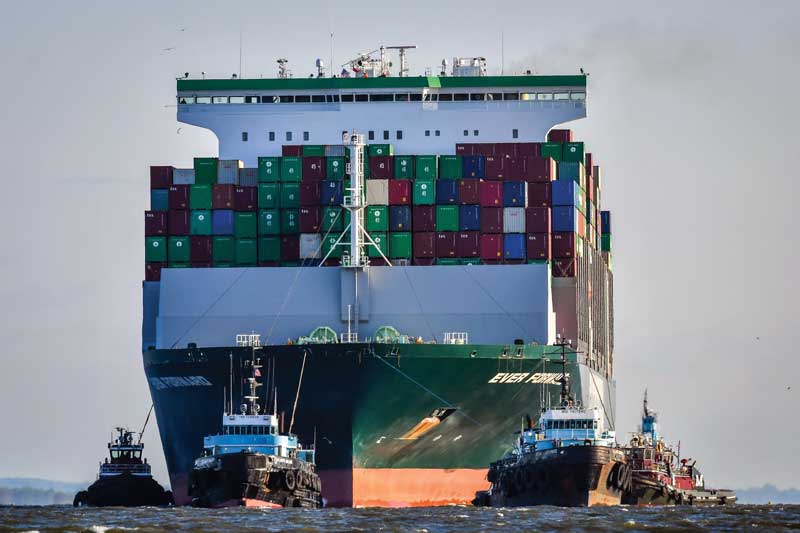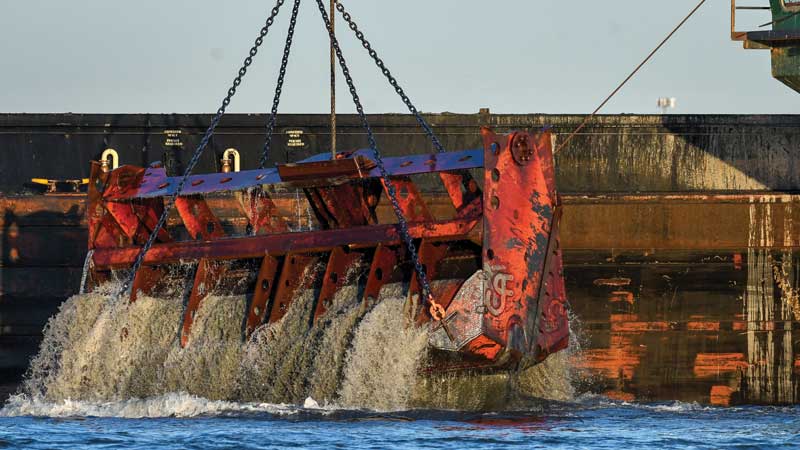The saga of the Ever Forward captured our attention like a spin-out in an auto race. We couldn’t help ourselves. We had to take a look—in person, on social media, on national television news. We were fascinated when, for more than a month, a massive vessel, penalized severely for leaving the shipping channel, was stuck in the soft but unforgiving muddy bottom of the Chesapeake Bay.

The enormous container ship, owned by the Taiwan-based company Evergreen Marine Corp., was carrying about 5000 containers when it departed Baltimore on March 13. For reasons that have not been determined as of the time of this writing, the vessel, which is 42 feet deep, 1096 feet long, and nearly 160 feet wide, left the Craighill Channel, seemingly missing a turn, and ran aground in about 24 feet of water near Pasadena, MD.
As word and photos of the ship’s grounding spread like wildfire across the Bay region, onlookers made their way to the shoreline for a better glimpse. Many boaters couldn’t resist cruising out to the sight of the grounding to survey the situation and take photographs. The Coast guard instituted a 500-yard safety zone around the Ever Forward, as jokes made their way around social media. Some followers of the saga called the gigantic vessel the Never Forward or the Ever Stuck. Most of us couldn’t believe it when we learned that the owner of the ship, Evergreen, also owned Ever Given, the infamous ship stuck in the Suez Canal in Egypt in March 2021.
Despite continuous efforts to refloat it, the ship was stuck until mid-April when it was freed on a Sunday morning that coincided with a full moon and high spring tide. It also happened to be Easter, prompting more silly jokes on social media, such as, “It is risen!”

The rescue of the ship was coordinated by the U.S. Coast Guard, working with the Port of Baltimore and Maryland Department of the Environment. Attempts to dislodge the vessel began with dredging. A first attempt to refloat the ship by pulling it with five tugboats failed. More dredging and more pulling ensued (this time with seven tugs) but, alas, this too failed. More than 84,000 cubic yards of mud from around the vessel was dredged and moved to Poplar Island.
Ultimately it was determined that the best way to refloat the ship was to remove some of the cargo containers. Cranes were brought in and in a dramatic effort offloaded 500 containers, equal to ten percent of the cargo, causing the ship to refloat slightly. The massive effort was timed to coincide with the month’s highest tide. The strategy proved to be a winning combination and freed the huge ship from the grips of the Bay’s mud and silt.
The vessel was then weighted down with water to pass under the Bay Bridge as it was pulled by tugboats to an anchorage south of Annapolis where it was inspected for damage. Next it returned to Baltimore to pick up the containers that had been removed. Finally, it headed off to Norfolk, its intended destination that fateful March morning. The short passage coincided with the Bay Bridge Boat Show, located at the foot of the Bay Bridge, and show-goers with fortuitous timing could see the ship as she slowly headed south.